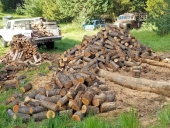
 1
1




John Daley Bendigo, Australia The Enemy of progress is the hope of a perfect plan
Benefits of rainfall collection https://permies.com/t/88043/benefits-rainfall-collection
GOOD DEBT/ BAD DEBT https://permies.com/t/179218/mortgages-good-debt-bad-debt
 8
8




 14
14




 6
6




Visit Redhawk's soil series: https://permies.com/wiki/redhawk-soil
How permies.com works: https://permies.com/wiki/34193/permies-works-links-threads
 3
3




 7
7





 3
3




Tradition is not the worship of ashes, but the preservation of fire.
 9
9




This is all just my opinion based on a flawed memory

 2
2




John said, "Has anybody thought when the last tree is cut or falls down, what will you use then?
I see waste beyond belief in Australia with wood fires, and I guess it happens in many places.
Invasive plants are Earth's way of insisting we notice her medicines. Stephen Herrod Buhner
Everyone learns what works by learning what doesn't work. Stephen Herrod Buhner
 3
3




John Daley Bendigo, Australia The Enemy of progress is the hope of a perfect plan
Benefits of rainfall collection https://permies.com/t/88043/benefits-rainfall-collection
GOOD DEBT/ BAD DEBT https://permies.com/t/179218/mortgages-good-debt-bad-debt
 6
6








John Daley Bendigo, Australia The Enemy of progress is the hope of a perfect plan
Benefits of rainfall collection https://permies.com/t/88043/benefits-rainfall-collection
GOOD DEBT/ BAD DEBT https://permies.com/t/179218/mortgages-good-debt-bad-debt




John C Daley wrote:Getting back to usage of wood.
Has anybody thought about the way they use it,
- having huge fires that are too hot,
- wood heater going with windows open
- sloppy insulation
- or none.
Visit Redhawk's soil series: https://permies.com/wiki/redhawk-soil
How permies.com works: https://permies.com/wiki/34193/permies-works-links-threads
 1
1




it was also built in the era when dry-wall and dry-wall mud was often contaminated with asbestos
When asbestos-laden drywall is dried and sealed with paint, it’s virtually harmless because it doesn’t emit loose airborne fibers. It was at the install stage that construction workers experienced severe airborne asbestos fiber exposure.
John Daley Bendigo, Australia The Enemy of progress is the hope of a perfect plan
Benefits of rainfall collection https://permies.com/t/88043/benefits-rainfall-collection
GOOD DEBT/ BAD DEBT https://permies.com/t/179218/mortgages-good-debt-bad-debt





 2
2




How Permies works: https://permies.com/wiki/34193/permies-works-links-threads
My projects on Skye: The tree field, Growing and landracing, perennial polycultures, "Don't dream it - be it! "
 2
2




John said, "I was aiming to be 'cheeky' about the waste of firewood in many instances
heat your home with 80% to 90% less wood
Invasive plants are Earth's way of insisting we notice her medicines. Stephen Herrod Buhner
Everyone learns what works by learning what doesn't work. Stephen Herrod Buhner
 3
3




Our inability to change everything should not stop us from changing what we can.
 3
3





|
This tiny ad dresses like this in public every day:
Homestead Pigs Course
https://permies.com/wiki/365748/Homestead-Pigs
|








